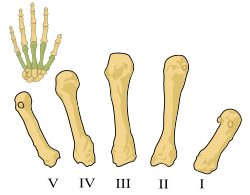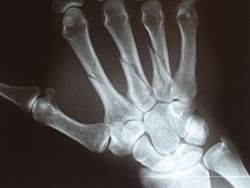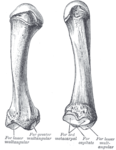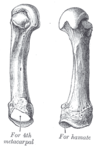- Metacarpus
-
Bone: Metacarpals The five metacarpal bones, numbered. (Left hand shown with thumb on right.) Multiple fractures of the metacarpals (aka broken hand). (Right hand shown with thumb on left.) Latin metacarpalia Gray's subject #55 227 Origins Carpus Insertions Proximal phalanges Articulations Carpometacarpal, intermetacarpal, metacarpophalangeal MeSH Metacarpus In human anatomy, the metacarpus is the intermediate part of the hand skeleton that is located between the phalanges (bones of the fingers) proximally and the carpus which forms the connection to the forearm. The metacarpus consists of metacarpal bones. Its equivalent in the foot is the metatarsus.
Contents
Human anatomy
The metacarpals form a transverse arch to which the rigid row of distal carpal bones are fixed. The peripheral metacarpals (those of the thumb and little finger) form the sides of the cup of the palmar gutter and as they are brought together they deepen this concavity. The index metacarpal is the most firmly fixed, while the thumb metacarpal articulates with the trapezium and acts independently from the others. The middle metacarpals are tightly united to the carpus by intrinsic interlocking bone elements at their bases. The ring metacarpal forms a transitional element of the semi-independent last metacarpal.[1]
Each metacarpal bone consists of a body and two extremities.
Body
The body (corpus; shaft) is prismoid in form, and curved, so as to be convex in the longitudinal direction behind, concave in front. It presents three surfaces: medial, lateral, and dorsal.
- The medial and lateral surfaces are concave, for the attachment of the interosseus muscles, and separated from one another by a prominent anterior ridge.
- The dorsal surface presents in its distal two-thirds a smooth, triangular, flattened area which is covered in by the tendons of the extensor muscles. This surface is bounded by two lines, which commence in small tubercles situated on either side of the digital extremity, and, passing upward, converge and meet some distance above the center of the bone and form a ridge which runs along the rest of the dorsal surface to the carpal extremity. This ridge separates two sloping surfaces for the attachment of the interossei dorsales.
- To the tubercles on the digital extremities are attached the collateral ligaments of the metacarpophalangeal joints.
Base
The base or carpal extremity (basis) is of a cuboidal form, and broader behind than in front: it articulates with the carpus, and with the adjoining metacarpal bones; its dorsal and volar surfaces are rough, for the attachment of ligaments.
Head
The head or digital extremity (capitulum) presents an oblong surface markedly convex from before backward, less so transversely, and flattened from side to side; it articulates with the proximal phalanx. It is broader, and extends farther upward, on the volar than on the dorsal aspect, and is longer in the antero-posterior than in the transverse diameter. On either side of the head is a tubercle for the attachment of the collateral ligament of the metacarpophalangeal joint.
The dorsal surface, broad and flat, supports the tendons of the extensor muscles.
The volar surface is grooved in the middle line for the passage of the flexor tendons, and marked on either side by an articular eminence continuous with the terminal articular surface.
Articulations
Besides the metacarpophalangeal joints, the metacarpal bones articulate by carpometacarpal joints as follows:
- the first with the trapezium;
- the second with the trapezium, trapezoid, capitate and third metacarpal;
- the third with the capitate and second and fourth metacarpals;
- the fourth with the capitate, hamate, and third and fifth metacarpals;
- and the fifth with the hamate and fourth metacarpal.
Insertions
Extensor Carpi Radialis Longus/Brevis: Both insert on the base of metacarpal II; Assist with wrist extension and radial flexion of the wrist
Extensor Carpi Ulnaris: Inserts on the base of metacarpal V; Extends and fixes wrist when digits are being flexed; assists with ulnar flexion of wrist
Abductor Pollicis Longus: Inserts on the trapezium and base of metacarpal I; Abducts thumb in frontal plane; extends thumb at carpometacarpal joint
Opponens Pollicis: Inserts on metacarpal I; flexes metacarpal I to oppose the thumb to the fingertips
Opponens digiti minimi: Inserts on the medial surface of metacarpal V; Flexes metacarpal V at carpometacarpal joint when little finger is moved into opposition with tip of thumb; deepens palm of hand.[3]
Congenital disorders
The fourth and fifth metacarpal bones are commonly "blunted" or shortened, in pseudohypoparathyroidism and pseudopseudohypoparathyroidism.
A blunted fourth metacarpal, with normal fifth metacarpal, can signify Turner syndrome.
Blunted metacarpals (particularly the fourth metacarpal) are a symptom of Nevoid basal cell carcinoma syndrome.
Fracture
The neck of a metacarpal (in the transition between the body and the head) is a common location for a boxer's fracture.
In other animals
In four-legged animals, the metacarpals form part of the forefeet, and are frequently reduced in number, appropriate to the number of toes. In digitigrade and unguligrade animals, the metacarpals are greatly extended and strengthened, forming an additional segment to the limb, a feature that typically enhances the animal's speed. In both birds and bats, the metacarpals form part of the wing.
See also
- Bone terminology
- Terms for anatomical location
- Carpometacarpal bossing
Additional images
Bones of left hand.Bones of left hand.Metacarpals of left hand, anterior aspectMetacarpals of left hand, medial aspectFirst metacarpal bone (left)Second metacarpal bone (left)Third metacarpal bone (left)Fourth metacarpal bone (left)Fifth metacarpal bone (left)Notes
This article was originally based on an entry from a public domain edition of Gray's Anatomy. As such, some of the information contained within it may be outdated.
References
- Tubiana, Raoul; Thomine, Jean-Michel; Mackin, Evelyn (1998). Examination of the Hand and Wrist. Taylor & Francis. ISBN 1853175447. http://books.google.com/books?id=G1gWHR1_J9UC&pg=PA10.
Bones of upper limbs (TA A02.4, GA 2.200–230) Pectoral girdle,
clavicleScapula fossae (subscapular, supraspinatous, infraspinatous) · scapular notch · glenoid cavity
tubercles (infraglenoid, supraglenoid) · spine of scapula · acromion · coracoid process
borders (superior, lateral/axillary, medial/vertebral) · angles (superior, inferior, lateral)Humerus upper extremity: necks (anatomical, surgical) · tubercles (greater, lesser) · intertubercular sulcus
body: radial sulcus · deltoid tuberosity
lower extremity: capitulum · trochlea · epicondyles (lateral, medial) · supracondylar ridges (lateral, medial) · fossae (radial, coronoid, olecranon)Forearm Hand carpus: scaphoid · lunate · triquetral · pisiform · trapezium · trapezoid · capitate · hamate (hamulus)
metacarpus: 1st metacarpal · 2nd · 3rd · 4th · 5th
phalanges of the hand: proximal · intermediate · distalCategories:- Bones of the upper limb
- Skeletal system
- Hand
Wikimedia Foundation. 2010.









